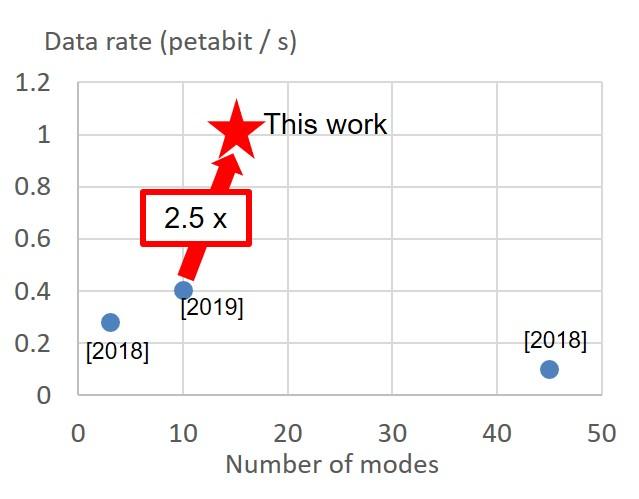
Credit: National Institute of Information and Communications Technology (NICT)
Points
- A world record transmission of 1 petabit per second in a multimode optical fiber increases the current record data rate in multimode optical fibers by more than 2.5 times.
- Wideband optical transmission in fibers with more 15 modes is demonstrated for the first time, enabled by mode multiplexers and a transmission fiber optimized for high optical bandwidth.
- This demonstration advanced high-density and large capacity transmission in optical fibers that can be produced with standard methods.
Abstract
A group of researchers from the Network System Research Institute of the National Institute of Information and Communications Technology (NICT, Japan) led by Georg Rademacher, NOKIA Bell Labs (Bell Labs, USA) led by Nicolas K. Fontaine and Prysimian Group (Prysimian, France) led by Pierre Sillard succeeded in the world’s first transmission exceeding 1 petabit per second in a single-core multi-mode optical fiber. This increases the current record transmission in a multi-mode fiber by a factor of 2.5.
To date, transmission experiments in optical fibers supporting large number of modes was limited to small optical bandwidths. In this study, we demonstrated the possibility of combining highly spectral efficient wideband optical transmission with an optical fiber guiding 15 fiber modes that had a cladding diameter in agreement with the current industry standard of 0.125 mm. This was enabled by mode multiplexers and an optical fiber that supported wideband transmission of more than 80 nm over a distance of 23 km. The study highlights the large potential of single-core multi-mode fibers for high capacity transmission using fiber manufacturing processes similar to those used in the production of standard multi-mode fibers.
The results of this study were accepted for the post-deadline session at the 46th European Conference on Optical Communication (ECOC 2020).
Background
Over the past decade, intensive research was carried out worldwide to increase the data rates in optical transmission systems using space-division multiplexing in order to accommodate the exponentially increasing data transmission requirements. Compared to multi-core optical fibers, multi-mode fibers can support a higher spatial-signal-density and are easier to manufacture. However, using multi-mode fibers for high capacity space-division multiplexed transmission requires the use of computationally intensive digital signal processing. These requirements increase with the number of transmission modes and realizing transmission systems supporting large number of fiber modes is an active field of research.
Achievements
At NICT, a transmission experiment was designed and carried out that utilized the transmission fiber made by Prysmian and mode multiplexers developed by Bell Labs. A wideband transceiver subsystem was developed at NICT to transmit and receive several hundred highly spectral efficient WDM channels of high signal quality. The novel mode multiplexers were based on a multi-plane light conversion process where the light of 15 input fibers was reflected multiple times on a phase plate to match the modes of the transmission fiber. The transmission fiber was 23 km long and had a graded-index design. It was based on existing multi-mode fiber designs that were optimized for wideband operation and had a cladding diameter of 0.125 mm and a coating diameter of 0.245 mm, both adhering to the current industry standard. The transmission system demonstrated the first transmission exceeding 1 petabit per second in a multi-mode fiber increasing the current record demonstration by a factor of 2.5.
When increasing the number of modes in a multi-mode fiber transmission system, the computational complexity of the required MIMO digital signal processing increases. However, the used transmission fiber had a small modal delay, simplifying the MIMO complexity and maintained this low modal delay over a large optical bandwidth. As a result, we could demonstrate the transmission of 382 wavelength channels, each modulated with 64-QAM signals. The success of large-capacity transmission using a single-core multimode optical fiber, which has a high spatial signal density and easy manufacturing technology, is expected to advance high-capacity multimode transmission technology for future high capacity optical transmission systems.
Future Prospects
In the future, we would like to pursue the possibility of extending the distance of large-capacity multi-mode transmission and integrating it with multi-core technology to establish the foundation of future optical transmission technology with large capacity.
The paper on the results of this experiment was published at the 46th European Conference on Optical Communication (ECOC2020, December 6th – 10th 2020), which is one of the largest international conferences related to optical fiber communication. It was planned to be held in Brussels, Belgium but had to be conducted virtually due to the Novel Corona Virus epidemic. The paper received a very high evaluation from and was adopted for presentation in a special session for the latest research (Post Deadline Paper) that took place on the 10th of December.
###
Media Contact
HIROTA Sachiko
[email protected]
Original Source
https:/




